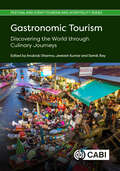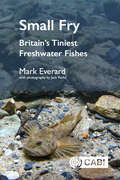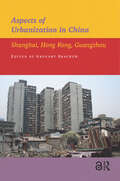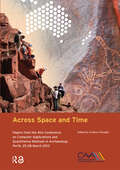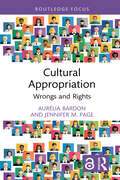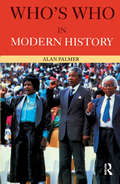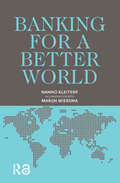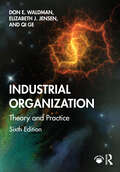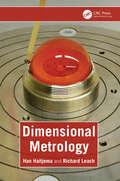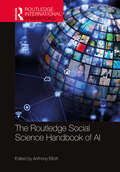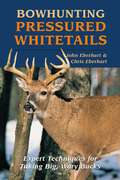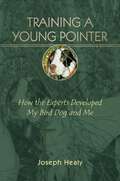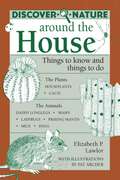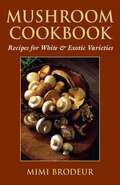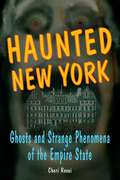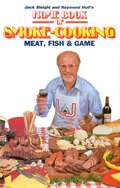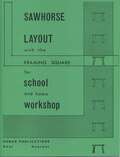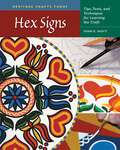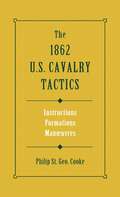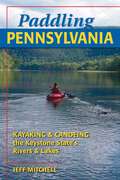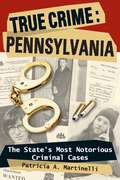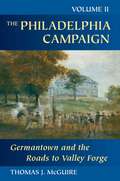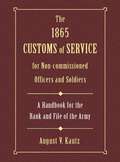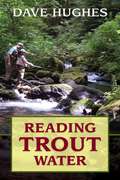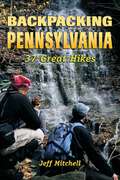- Table View
- List View
Gastronomic Tourism: Discovering the World through Culinary Journeys (Festival and Event Tourism and Hospitality Series)
by Anukrati Sharma Jeetesh Kumar Samik RayGastronomy is a fundamental aspect of culture and the food and cuisine of any region can provide rich insights into the local lifestyle and traditions. Gastronomic tourism therefore involves visiting food producers, restaurants, food festivals or other establishments where visitors can dine and experience the typical products of a region. It is an enjoyable way for tourists to discover the cultural heritage of the places they visit and culinary pleasure is becoming an increasingly decisive factor when choosing a travel destination. In certain regions, gastronomy has been recognised as an Intangible Cultural Heritage (by UNESCO) and the promotion of local traditional cuisine can be a way to rediscover and preserve local or regional values through culinary riches. Gastronomic tourism is also a factor of economic improvement for different destinations, particularly in developing countries. The value of this book includes: Providing a comprehensive and well-rounded exploration of gastronomic tourism, with a broad coverage of topics addressing key aspects such as culture, economics and sustainability. Contributions by scholars from many different countries using an interdisciplinary approach that includes insights and practical examples to engage a more diverse audience. Offering a key resource for those involved in tourism who want to learn how the gastronomic potential of different cultural contexts and geographical locations can be understood. It is part of a CABI series of books on festival and event tourism and hospitality edited by an experienced academic author on tourism. This book emphasises the importance of many related factors in gastronomic tourism, which often focuses exclusively on food and cooking rather than the whole experience. The book therefore also focuses on culture, commitment, passion, learning, emotions and experiences associated with gastronomy and considers how gastronomic tourism can contribute to achieving Sustainable Development Goals.
Small Fry: Britain's Tiniest Freshwater Fishes
by Mark EverardDespite being among the most widespread and common fish in the UK there is still a lack of knowledge about the small freshwater fish species that inhabit our rivers and waterways. Often neglected but endlessly charming, these small fish are, for many, their first childhood encounter with the underwater world and inspire a lifelong interest and enduring fascination. As threats to biodiversity grow and conservation efforts intensify, it is important to remember that fishes are wildlife and that common yet overlooked species require respect and wider consideration. Providing details of their biology, the wider angling interest and many other social dimensions, this book celebrates Britain's small freshwater fishes and recognises their importance to both the academic and general fish enthusiast. The value of this book includes: * Providing detailed systematic descriptions of some well-known but less well understood UK small fish species. * Written by a popular and knowledgeable broadcaster (BBC Springwatch) and author adept at crafting works that are valued by joint audiences (academics, general fishermen and beginner anglers). * Illustrated with photographs from acclaimed underwater photographer, Jack Perks. * Recognising that small freshwater fish species are important wildlife and that there are great stories to be told about our littlest fishes. This book shines a light on the range of familiar but less studied UK small freshwater fish species for academic use but it is also written for the accessibility of a general readership. It is an engaging, factual and beautifully illustrated account of these wonderful, tiny creatures and brings their stories to life.
Aspects of Urbanization in China: Shanghai, Hong Kong, Guangzhou (IIAS Publications series)
by Gregory BrackenChina’s rise is one of the transformative events of our time. Aspects of Urbanization in China: Shanghai, Hong Kong, Guangzhou examines some of the aspects of China’s massive wave of urbanization – the largest the world has ever seen. The various papers in the book, written by academics from different disciplines, represent ongoing research and exploration and give a useful snapshot in a rapidly developing discourse. Their point of departure is the city – Shanghai, Hong Kong and Guangzhou – where the downside of China’s miraculous economic growth is most painfully apparent. And it is concern for the citizens of these cities that unifies the papers in a book whose authors seek to understand what life is like for the people who call them home.
Across Space and Time: Papers from the 41st Conference on Computer Applications and Quantitative Methods in Archaeology, Perth, 25-28 March 2013 (Computer Applications and Quantitative Methods in Archaeology)
by Arianna TravigliaThis volume presents a selection of the best papers presented at the forty-first annual Conference on Computer Applications and Quantitative Methods in Archaeology. The theme for the conference was Across Space and Time, and the papers explore a multitude of topics related to that concept, including databases, the semantic Web, geographical information systems, data collection and management, and more.
Cultural Appropriation: Wrongs and Rights (Routledge Focus on Philosophy)
by Aurélia Bardon Jennifer M. PageFrom the fashion label Dior being accused of cultural appropriation after using American Indian imagery in an ad campaign for its “Sauvage” fragrance, to the backlash against Kendall Jenner’s afro-esque hairstyle in Vogue, debates about cultural appropriation have reached a fever pitch. In this much-needed analysis of the phenomenon Aurélia Bardon and Jennifer Page step back and ask: when is cultural appropriation wrong and when are we right to criticize it?Their analysis of wrongful cultural appropriation centers on three questions: whether appropriation involves theft; whether it communicates disrespect; and whether it disregards requests made by marginalized groups about their cultural practices. Sometimes, they argue, it is structural injustice rather than individual wrongdoing that is at stake. They examine cultural appropriation’s political dimensions, asking whether the state should be neutral between appropriative and non-appropriative artistic expression. They contrast bans on wrongful cultural appropriation and the state’s using its expressive power as a speaker, spender, and educator to discourage it. They also consider the ethical questions that arise when cultural appropriation debates spur further debates about online shaming and cancel culture.Using cases from music, fashion and the arts, Cultural Appropriation: Wrongs and Rights will be of great interest to students and researchers in philosophy, politics and related subjects, such as race and ethnic studies, sociology, and cultural studies.The Open Access version of this book, available at http://www.taylorfrancis.com, has been made available under a Creative Commons [Attribution-Non Commercial-No Derivatives (CC BY)] 4.0 license. Supported by the Publication Fund of the University of Konstanz, Germany, and the Open-Access Publication Funding Program of the Office for the Advancement of Research at John Jay College, City University of New York, USA.
Who's Who in Modern History
by Alan PalmerWho's Who in Modern History is a unique reference book which examines those individuals who have shaped the political world since 1860. Coverage is truly global, including the most important figures in Europe, Asia, North America, Latin America, Africa and Australasia.It provides:* an easy-to-use A-Z layout* authoritative, detailed biographies of the most important figures since 1860, from Clemenceau and Chief Buthelezi to King Fahd and Benazir Bhutto* bibliographical references for each entry, to aid further research* extensive cross-referencing* an essential guide for students, researchers and the general reader alike.
Banking for a Better World: Nanno Kleiterp in Conversation with Marijn Wiersma
by Nanno KleiterpWhen we look at all the challenges facing the world, including inequality, population migration, and climate change, we can see a role for development banking in nearly all of them. But will that role be played for good or ill? This book brings together two people who collectively draw on their forty-five years of experience in that world to argue that development banking can-and must-play a constructive role., We only need to read the news to find public outrage at tales of short-sighted greed in the financial world. But what happens when banks invest in long-term sustainability? Readers will find a fascinating example in the journey of the Dutch development bank FMO. At times global in perspective, at other moments intimately personal, Banking for a Better World interweaves candid anecdotes with development history, as well as banking lessons with client interviews, to deliver a powerful argument for a business model that generates profit through impact, and impact through profit., This is an important and accessible must-read for anyone involved in banking, business, policy making, and civil society as a whole. Banking for a Better World challenges us to start finding overlaps between our own lives and global issues and to bridge the distance between our personal needs and those of our planet.
Industrial Organization: Theory and Practice
by Don E. Waldman Elizabeth J. Jensen Qi GeIndustrial Organization: Theory and Practice blends a rigorous theoretical introduction to industrial organization with empirical evidence, real-world applications, and case studies. It also supports students with a range of theoretical and applied problems and exercises. This balanced approach has earned the book its place as one of the leading undergraduate texts on industrial organization.The sixth edition has significantly expanded and updated theories, empirical findings, applications, industry landscapes, policies, and cases throughout the book to reflect the latest developments in the field. Major updates include: additional theoretical concepts (with applications) addressing current trends in business practices, such as platform markets, algorithmic pricing, monopsony, killer acquisitions, subcontracting, subscription plans, influencer marketing, and network effects recent developments in public policy toward Big Tech and dominant platforms, labor market concentration, algorithmic collusion, and net neutrality greater emphasis on global perspective with a broader range of international examples, applications, and cases enhanced coverage of empirical approaches in industrial organization, including an introduction to discrete choice models and difference-in-differences methods a supplementary digital resource package, offering additional learning and teaching materials This comprehensive book bridges the gap between economic theory and real-world case studies in an accessible, logical manner, making it the ideal undergraduate text for courses on industrial organization.
Dimensional Metrology
by Richard Leach Han HaitjemaThis book provides in-depth coverage of metrology principles for students, practicing engineers, technologists and researchers.Dimensional Metrology presents and explains mathematical principles and treatments and practical applications of metrology, with numerous chapter exercises that link theory to the solution of practical problems. Computer-based classes of dimensional metrology are covered, such as CMM-technology, areal surface measurement and X-ray computed tomography. Readers are shown how to perform and evaluate dimensional measurements and interpret the results. Measuring instruments and methods are explained so that readers can determine which one to use for specific applications.This book aims to give both technicians and academic researchers in the field a thorough understanding of both the mathematical principles and uses and their applications. It can well act as the basis for a course series at the bachelor’s and master’s level for students in mechanical engineering.
The Routledge Social Science Handbook of AI (Routledge International Handbooks)
by Anthony ElliottThe Routledge Social Science Handbook of AI is a landmark volume providing students and teachers with a comprehensive and accessible guide to the major topics and trends of research in the social sciences of artificial intelligence (AI), as well as surveying how the digital revolution – from supercomputers and social media to advanced automation and robotics – is transforming society, culture, politics and economy. The Handbook provides representative coverage of the full range of social science engagements with the AI revolution, from employment and jobs to education and new digital skills to automated technologies of military warfare and the future of ethics. The reference work is introduced by editor Anthony Elliott, who addresses the question of relationship of social sciences to artificial intelligence, and who surveys various convergences and divergences between contemporary social theory and the digital revolution.The Handbook is exceptionally wide-ranging in span, covering topics all the way from AI technologies in everyday life to single-purpose robots throughout home and work life, and from the mainstreaming of human-machine interfaces to the latest advances in AI, such as the ability to mimic (and improve on) many aspects of human brain function.A unique integration of social science on the one hand and new technologies of artificial intelligence on the other, this Handbook offers readers new ways of understanding the rise of AI and its associated global transformations. Written in a clear and direct style, the Handbook will appeal to a wide undergraduate audience.
Bowhunting Pressured Whitetails
by Chris Eberhart John EberhartLearn how to scout and prepare sites while leaving minimal evidence of human presence, and how to read deer sign to find the most productive places to hunt. Comprehensive coverage of scent control, including the use of odor-eliminating clothing.
Training a Young Pointer
by Joseph HealyThe story of a bird dog's early years, showing how an owner selects a pup and finds a trainer. Tips on housebreaking, socialization, basic commands, field training, whistle training and ranging methods, types of training collars, using a check cord, release and fetch commands. Interviews and insights with longtime pointing-dog owners, trainers, and other experts.
Discover Nature Around the House (Discover Nature Series)
by Elizabeth LawlorThough we often think of the natural world as lying far from our front door, often the most interesting aspects of nature can be found in the kitchen, basement, or backyard. Discover Nature Around the House explores the properties, processes, and phases of the plant and animal life in our own homes, from ferns and cacti to spiders and dogs. With just a few essentials, such as a field notebook, hand lens, and bug box, readers will find both straightforward information and all kinds of activities to uncover the fascinating, diverse ecosystems that flourish right our noses.
Mushroom Cookbook
by Mimi BrodeurRecipes for appetizers, soups, sandwiches, side dishes, and entrees. How to select, clean, store, and prepare. Mediterranean Mushroom Bruschetta, Mushroom Vegetable Soup, Chicken Mushroom Fajitas, Penne Mushroom Vegetable Pasta.
Haunted New York (Haunted Series)
by Cheri Farnsworth• More than 60 frightening tales • Covers all regions of the state An entertaining look at supernatural phenomena in New York, including the ghost of a British soldier at Fort Ontario, Champ the Lake Champlain monster, the haunted castle of Captain Beardslee, spirits in Manhattan's oldest house, the alien abduction at the Brooklyn Bridge, and many more.
Home Book of Smoke Cooking Meat, Fish & Game
by Raymond Hull Jack SleightHow to smoke a variety of foods, including turkey, cheese, sausage, fish, beef, nuts, wild game. A classic reference.
Sawhorse Layout with the Framing Square for School and Home Workshop
by Forrest W. Bear Thomas HoernerThis manual offers step-by-step sawhorse construction procedures. Four quality worksheets (Carpentry Hand Tools, Glues, Nails and Screws) are included to assist students in learning and to assist in teaching this instructional area. The manual also includes plans for constructing eight other types of sawhorses. An excellent addition to any carpentry instructional unit. ,
Hex Signs (Heritage Crafts)
by Ivan E. HoytThe traditional Pennsylvania Dutch folk practice of painting colorful, round geometric designs directly on barns was adapted to a detached disk format in the mid-twentieth century. Ivan E. Hoyt is one of the most celebrated artisans of hex sign painting, and in this detailed how-to book he shares his knowledge, providing information on tools, step-by-step instructions and photographs, design ideas, and painting tips. Projects include rosette, star, tulip, maple, and oak designs.
1862 US Cavalry Tactics
by Philip St. CookeDirected by the U.S. War Department in 1859 to prepare a new, revised manual for U.S. cavalry operations, then-Col. Philip St. George Cooke produced this book after extensive research of cavalry tactics used by the advanced nations in Europe, where he had been an observer in the Crimean War (1854-1856). Originally published in 1860, the book was revised in 1861 and 1862. This 1862 Government Printing Office edition combines the former two volume work into one book.
Paddling Pennsylvania
by Jeff MitchellMaps and descriptions for more than 200 Pennsylvania waterways. Information on minimum water levels, potential hazards, and difficulty level of each stream. Includes directions and recommendations for put-in and take-out at each site.
True Crime: Pennsylvania (True Crime)
by Patricia A. MartinelliThe history of criminal offense in Pennsylvania is documented in this book, beginning with a general survey of crime in the state and then focusing on its headline cases.
Philadelphia Campaign
by Thomas J. McGuireBased on soldiers' and civilians' vivid accounts--many uncovered for the first time from private collections--the story of the compelling fight for independence reaches its most desperate moments. This second in a two-volume set follows the saga from Cornwallis's triumphal march of his British and Hessian troops into Philadelphia in late September to Washington's movement of the weary Continental forces to camp at Valley Forge in December.Defeated at Brandywine, the Continental forces were worn out and ill equipped. Yet on October 4, Washington embarked on his first major offensive of the war--a surprise attack at dawn on Howe's main camp at Germantown. Only narrowly defeated, the Continentals gained valuable experience and new confidence in the possibility of victory. The seige of the Delaware River forts--one of the bloodiest and prolonged battles of the war--ended with British success in mid-November, but still Howe failed to end the war. He tried unsuccessfully to draw Washington from the fortified hills of Whitemarsh. As the Continental forces moved to Valley Forge for the winter, they would have to face their greatest challenge--survival.
1865 Customs of Service for Non-Commissioned Officers & Soldiers
by August KautzReproduction edition of the Civil War era guidebook. Indispensable for historians and reenactors.
Reading Trout Water
by Dave Hughes• Second edition, completely updated in full color • Covers every water type--riffles, runs, pools, flats, pocket water, bank water • Learn how to find trout by studying currents, temperatures, oxygen levels, and food sources • 140 color photos pinpoint trout locations in specific water types
Backpacking Pennsylvania
by Jeff MitchellDetailed descriptions of 37 trails. Information on terrain, difficulty, precautions, contacts. Directions to each trail and descriptions of features along the trek.
